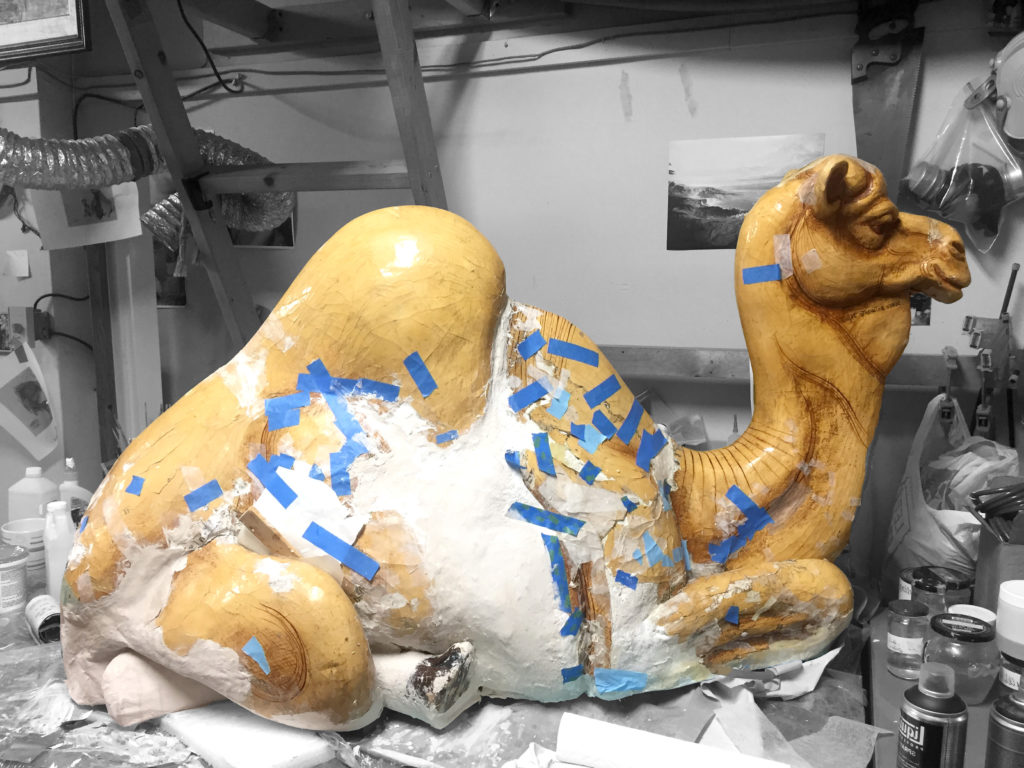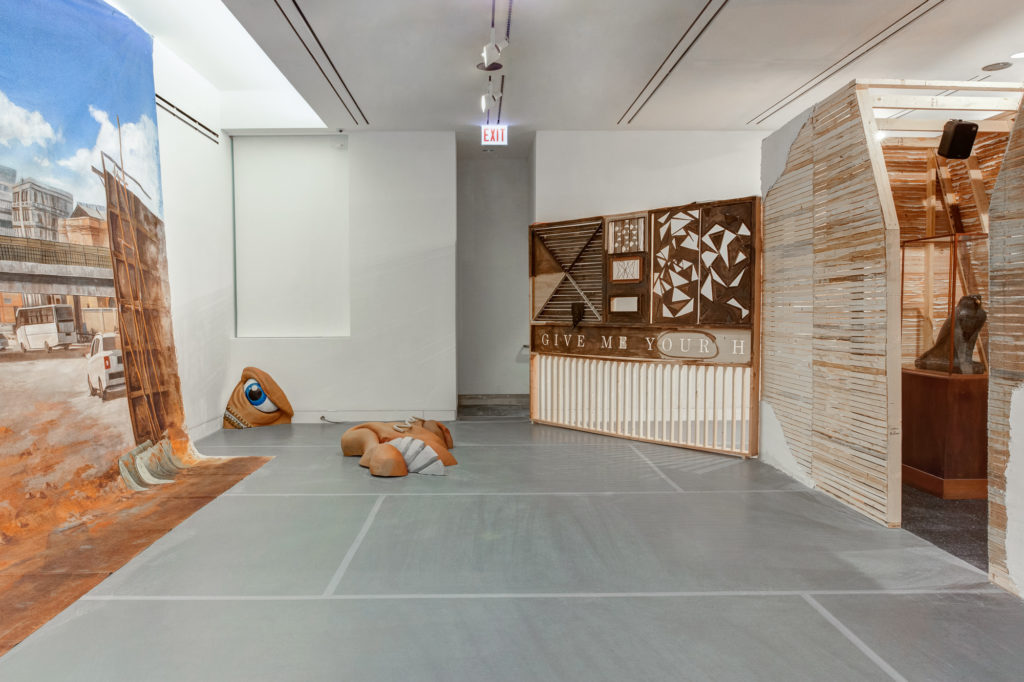The Last Acts: Atlas Unlimited
by Gabrielle Welsh

“She’s here! She’s arrived.”
You are greeted by a gallery attendant, no, beckoned in with a yell. Barely four steps into the exhibition hall, you do not have an option to politely wave your hand, nor retreat back into the lobby of the space. An eccentric young man pulls you into a group tour that seems to have already begun. You blush from the unnecessary fear of participating in anything performative. Even worse, they can read your discomfort, and are playing with it. Sheepishly, you join the performance.
Performers activate the galleries of artists Karthik Pandian and Andros Zins-Browne in Atlas Unlimited (Acts V-VI), currently on view at the Logan Center for the Arts, on Thursdays throughout the run of the exhibition, and are lovingly dubbed ‘Builders.’ The greeter who initially beckoned me, Builder Sami Ismat, goes back to looking at a thoroughly marked-up printed document and continuing a monologue to both a wall and a statue in the corner (Karthik Pandian and Andros Zins-Browne with De Looizemaanen and Niklas Müller’s Carnaval. Aalst, 2018). Whatever act I was pulled into continues. This performance, though, is not an actor engaging with an unmoving audience. Rather, the performance is structured as a tour through an exhibition, given by Builder Tasha Vorderstrasse. I cannot help but question how much of a performance this is, though there is the slight humor of a guided tour through a quite tiny exhibition. What did I get myself into?
Now in its third touring iteration at Logan Center Exhibitions, the duo of Pandian and Zins-Browne concocts an elaborate future-reality built on a fusion of the historic—and by this, primarily largely overlooked histories—and fiction. The Atlas project, which has bred films, performances, and installations of similar names dating back to 2012, was born out of a need to address the Arab Spring through art; specifically, art that examines the complexity of a digital revolution never fully realized—migratory bodies not just in the Arab region, but also globally, to address the ways in which artists must confront these realities.1 This project was followed by Pandian and Zins-Browne meeting a Syrian refugee named Zakaria Almoutlak in 2017; he was once a sculptor alongside his father living in Palmyra, Syria. Writer Aruna d’Souza best tells this tale: “[Almoutlak] and his father decided, against their better judgment and beliefs, to accept a commission from a wealthy emir to create a counterfeit ancient sculpture of a rearing camel… The sculpture was, as it happened, destroyed by ISIS forces when they took over the city, including the museum, in 2017, forcing Almoutlak to flee the city.”2 In this way, Atlas Unlimited in its current iteration in Chicago tells this story through a camel.
Beginning in Aalst, Belgium at Netwerk Aalast, Act I-III weaves the past and future into public performances. A giant camel is thrown a carnival in Act I-II, then cut into pieces and taken on a journey throughout Europe and North America. Here, the backdrop for the exhibition builds. Act III takes place in 2028; the Syrian war is over and Almoutlak has returned to Palmyra where he reveals a new camel sculpture; he then destroys it. Act IV enacts a performative lecture by the sculpture through Antwerp, which I can only imagine brings along with it the fragmented remains. Here, in Chicago, the sculpture is to be rebuilt by a conservator, that is, among the other twenty or so stories being told by each individual builder.
And so, the ‘tour’ at the Logan Center continues. Following that lengthy, yet condensed, explanation of the history of this exhibition, you may think the tour will follow this young sculpture’s life and imagined future, but no—instead, we are focused on the 1893 World’s Columbian Exhibition. If you are from or live in Chicago, you either love or hate the recent rise of obsession with this historic moment. Somehow, we are here again.

The Builder, Vorderstrasse, is discussing a labor strike that occurred in the building of the “Street in Cairo” attraction of the fair, which built a palatable replication of the Egyptian capital. Think Epcot in Chicago—yet somehow much more exotified. The builder tells us of workers who were brought to the States from Egypt, Algeria, and other areas of the then-Ottoman empire to work throughout the attraction. The workers were treated poorly by the director/manager of this Cairo operation, George Pangalos, and realized that a unified, general strike among them would result in better working conditions and/or pay. As we turn the corner of the gallery, Vorderstrasse tells us that the leaders of these strikes were ‘sent’ back to their homelands; a few years later, as “news travels slowly back then,” their families have still not heard from them.3 We come into a room where a beautiful wedding tent is being built—though this tent has no visible connection to this story being told— and the previous subject matter is dropped altogether.
We are introduced to the Builder, Mohammad Miah, who is spending the duration of the exhibition building this tent, which is housing the previously-destroyed sculpture by Almoutlak. Though Jane Foley, the professional conservator painstakingly piecing back together this lost artifact is not in residence today, I am assured she will be back and will get to the bottom of what this sculpture was. As I leave this small guided tour, there are film backdrops, ever-expanding drawings of landscapers done directly on the gallery wall, and a replicated sculpture found in the ruins of “San Diego.” Though I do not mean to glaze over these aspects of the exhibition, rather, I cannot fit them all into one small article: there are just so many stories to be told. The director and curator of the Logan Center, Yesomi Umolu, sums this up act of telling multiple stories: “the project creates a space for speculation on the potential of recuperating memories and identities in increasingly unstable times.”4 Many memories, indeed.
As I walked throughout the exhibition, I was struck by its parafictional quality—a term first introduced through Carrie Lambert-Beatty’s 2009 piece, Make-Believe: Paraficition and Plausibility.5 Parafiction, as the author defines it, is a mode of performance in which a fiction is presented as a truth; the point of these pieces often being to expose a reality or truth through this mode of semi-deceptive storytelling. Lambert-Beatty cites the Yes Men6 as an obvious well-known pair of parafictioners; my own favorite enactment being one in which the men charade as representatives of the Royal Dutch Shell in NYC’s Columbus Circle, giving out free snow cones made of the “last iceberg in existence.”7
The point of the Yes Men’s temporary snow cone shop, which can be seen within the context of the Logan Center’s iteration of Atlas Unlimited, is not to maliciously deceive an audience into believing, but to rather use that initial moment of belief—the “You cannot destroy and sell this iceberg!” instance—to illuminate the quite similar, actual events happening. Additionally, this mode breaks a hierarchy of knowledge that favors written, academic, and state-sponsored ideologies over the artistic and the performative. Performance Studies pioneer and ethnographer Dwight Conquergood sees this mode as, “struggl[ing] to open the space between analysis and action, and to pull the pin on the binary opposition between theory and practice.”8 Within the small space of the Logan Center, Atlas Unlimited builds an entire world—it just had to travel from Syria to Belgium to Chicago.
Once the tour has officially concluded, I am pulled into yet another performance with the initial Builder. My cheeks redden. I learn that Ismat, this builder, is acting—workshopping a play on the life of Almoutlak, who in the setting of Acts V-VI, takes on that of a legendary historic figure. This very real, and still alive, man is played in Chicago as a sculptor of the past. I am asked to ‘translate’ for Ismat—which at this point, my Missouri public school roots and capacity to speak only one language begin to show. He goes along with it; we both agree that Westerners are bad and someone else is sucked into the performance. They do the polite hand shake of “no thanks”; he does not listen.

I leave the exhibition confused and a bit bewildered, but that may just be the point. The amalgamation of these histories and narratives—and furthermore, their proximity to you, the gallery-goer—make the complicated ways in which global exchange and migration affects our bodies physical.
Atlas Unlimited thoughtfully melds real histories and performative fictions in a seamless way—I am left wondering what of I heard was true, and what was not. Returning to my apartment, far from Hyde Park and the rigidness of the University of Chicago campus, I dig into articles written about the pair (mostly from European outlets), and almost wish that I would not have. Without this research, I would have been left wondering if what I was told had been a truth or a lie. But then too, I must step out of that belief, as this exhibition asks us to do: truth is subjective, and the word’s constant utterance (especially in a realm of so-called politics) has rendered it almost meaningless. Multiple truths prevail, and the myth of a universal truth is weaponized. Through each story told by each builder, whether from Pymara, Chicago, Brussels, or Antwerp, these separate, yet globally connected, truths are revealed. You decide what to do from there.
Karthik Pandian & Andros Zins-Browne: Atlas Unlimited (Acts V—VI) runs at Logan Center Exhibitions until March 17, 2019.
- D’Souza, Aruna. Read More About The Exhibition: The Migratory Work Of Atlas Unlimited
- Ibid.
- I later learn Vorderstrasse is a Research Associate at the University of Chicago’s Oriental Institute, and curated a small exhibition on this history in 2015.
- Umolu, Yesomi. Atlas Unlimited (Acts V–VI). Logan Center Exhibitions. Exhibition Handout.
- Lambert-Beatty, Carrie. “Make-Believe: Parafiction and Plausibility.” October129 (2009): 51-84.
- Ibid., pg. 62
- Stone, Rolling. “Watch the Yes Men Impersonate Shell, Make ‘Last Iceberg’ Snow Cones.” Rolling Stone, June 12, 2015.
- Conquergood, Dwight. Cultural Struggles: Performance, Ethnography, Praxis. Edited by E. Patrick Johnson. Ann Arbor, MI: University of Michigan Press, 2013.